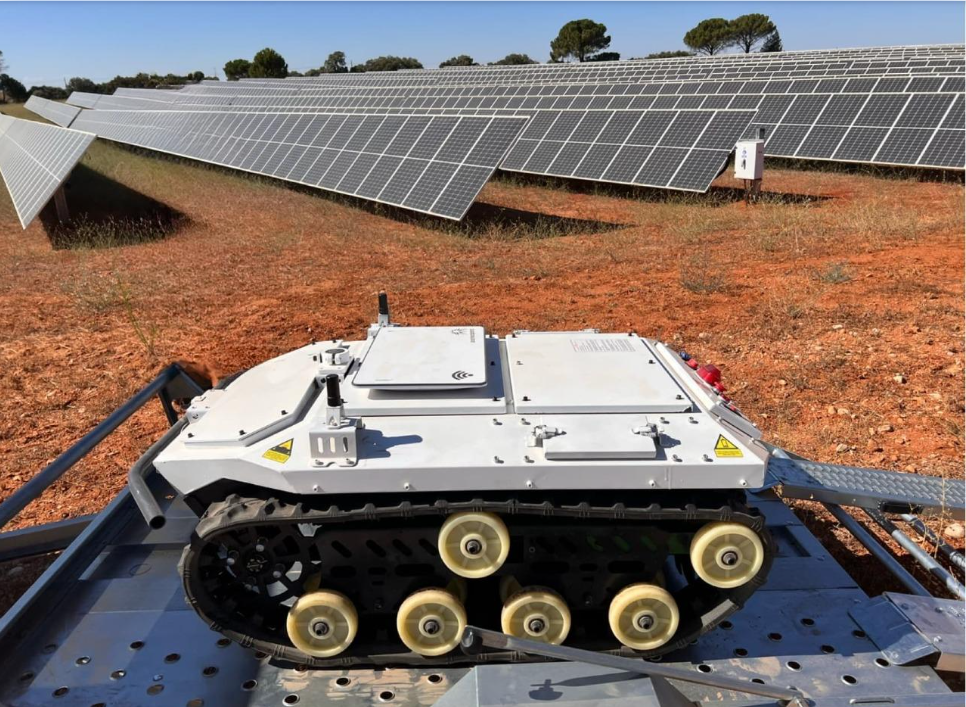A robot to monitor the solar panels that tours the photovoltaic installations
19 Dec 2023

Arbórea remotely deploys these autonomous systems for the sustainable management of large photovoltaic plants. Walk through the installation monitoring the correct operation of the panels and the electrical circuit.

It is the vanguard of clean energy. Because? It is placed at prominent points to observe vigilantly and give timely warning. Nothing escapes her eyes. Not even in his ears. Any changes are recorded to act accordingly. Antecursor II is the first civil robot capable of operating autonomously anywhere in the world thanks to the satellite coverage of the Starlink network, and it does so by running only on renewable electrical energy.
“It combines cutting-edge technologies to facilitate the integration of large photovoltaic plants into their natural environment, reduce fire risks and control maintenance costs,” explains Carlos Bernabéu González, CEO, founding partner and president of Arbórea Intellbird, a company from Salamanca that is behind this peculiar robot.
In this sense, he comments that he bases his automatic movement, precise to the centimeter, on a unique process inspired by the hunting strategies of the genet, a nocturnal predator capable of moving with precision in the dark. “The communications system allows Arbórea to monitor in real time the entire fleet of robots deployed in photovoltaic plants in remote locations through its Virtual Control Tower tool.”
On this platform, Bernabéu González affirms that, apart from continuing to provide coverage for the drone inspection pilots of large companies’ energy infrastructure, it can automatically receive all the information on the status of the systems of each robot in real time, as well as alerts associated with the anomalies detected in photovoltaic plants.
It has two functions. On the one hand, it allows generating an inspection process in search of thermal anomalies, not only in the upper part of the panels, as carried out by drones, but also simultaneously in all their lower structures, such as clips, fuse holders, staples or wiring, that escape the aerial view and are the most likely to generate risk hot spots.
“The inspection autonomy of the robot far exceeds that of any other system, given that it is above 30 hours,” he emphasizes and then adds that it offers the possibility of carrying out inspections of the photovoltaic infrastructure, without require the intervention of a person. It achieves this, according to the CEO, founding partner and president of Arbórea Intellbird, thanks to a set of high-resolution thermographic sensors that continuously take thousands of measurements of the installation. «This great mass of digital data is
processed on board by AI.
With this magic behind each of the steps it takes, the system detects anomalies, evaluates them based on the conditions of the plant and reports an early identification of possible failures,
all in real time. The result, he celebrates, is that the technicians of the company that owns the park receive on their mobile phones an email with the alert, the position of the anomaly and a thermography with the reference values. “This guarantees early intervention by the technician to avoid fire risks,” he adds.
To do this, the robot tours the photovoltaic plants continuously and regularly, monitoring the correct functioning of the panels and the electrical circuit, processing the information, detecting anomalies and reporting any value that could lead to deterioration of the elements automatically. «Continuous remote monitoring of the robot’s vital signs allows Arbórea to detect problems early and keep all systems continually updated, no matter how remote the location in which they operate. This offers the option of providing high coverage to our clients, without having to travel to the field, which results in greater efficiency and a very notable reduction in CO2 emissions and costs.”
Another use, as explained by Carlos Bernabéu González, is that Antecursor II has an integrated vegetation clearing system, manufactured based on aeronautical materials, to generate a fine grinding of the vegetation, which can be done cleanly. and very quiet. «This 100% electric plant management avoids contamination of the soil by oils or fuels, greenhouse gas emissions, the risk of fire associated with hot engines, or the breakage of panels due to stone projection from traditional systems of disc or filament clearing. Added to this, he says, is that this continuous autonomous cutting encourages the increase of carpeting species, thus achieving greater control of dust, so pernicious when it is deposited on the panels. “The generation of a layer of basal vegetation prevents desertification due to runoff and favors the maintenance of living soils and, therefore, the maintenance of biodiversity in photovoltaic plants,” he says.
Asked about the innovation of this platform, the CEO, founding partner and president of Arbórea Intellbird boasts that it is the first autonomous robot dedicated to this type of tasks. «To date, drones or robots moved under the control of a pilot, taking data that was later processed in search of anomalies. Antecursor II does not require a pilot, it takes data, processes it, analyzes and detects anomalies, evaluates them and reports directly to the maintainer autonomously, integrating the latest technologies that include AI. A “pioneering” system and an “international milestone” that is already deployed in large Spanish plants.
Looking to the future, the company from Salamanca provides international support to the leaders of wind energy in the intelligent maintenance of their blades, by having their fleets analyzed extremely precisely thanks to the technology developed. For this reason, they aspire to provide global support for the expansion of photovoltaics, so that it is safe and respectful of the soil and biodiversity.
Source: El Mundo de Castilla y León
This solar plant in Salamanca is controlled by a robot that is also a gardener: Antecursor II
Iberdrola and Arbórea innovate the management of solar plants with the ‘Antecursor II’ robot


